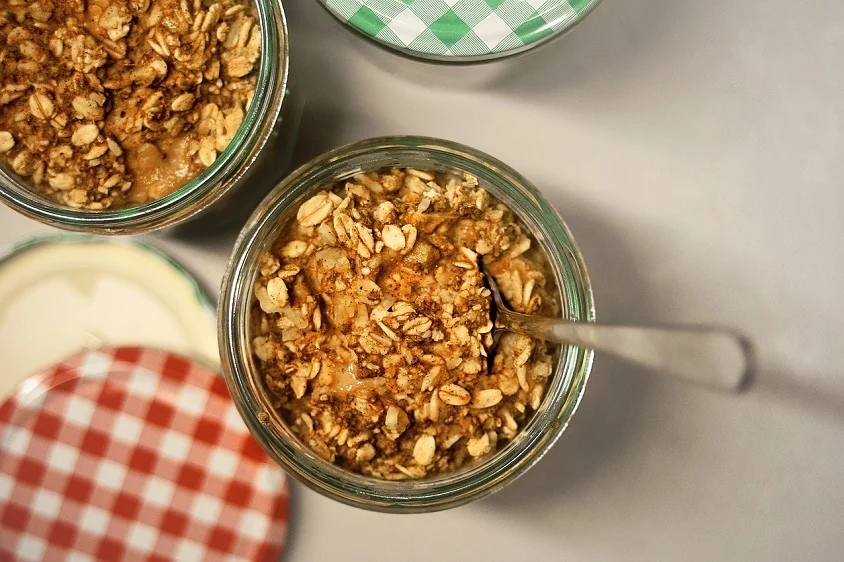I Ate Oatmeal Every Morning for a Month – Here’s What Happened to My Body
- Updated on: Feb 18, 2025
- 4 min Read
- Published on Feb 18, 2025

Oatmeal has long been praised as a nutritious and heart-healthy breakfast option. I decided to eat oatmeal every morning for an entire month to see what effects it would have on my body out of curiosity. I wanted to understand if it would really help with digestion, energy levels, glucose levels, and overall well-being or is it just a myth that’s spread so commonly among general public? Here’s what I experienced. Please note that this is my personal experience, and it may vary for different persons. But it would at least give a general guideline about how outmeal works and whether we should incorporate it in our diet.
What Is Oatmeal?
Oatmeal is a dish that is made from grains of the oat plant. It is made from ground oat groats (also called “milled oats”), steel-cut oats or rolled oats. Oat groats are the seeds of the oat plant. The hull is removed to get the seeds.
Oatmeal can be eaten raw with milk, like a cereal. Some people cook and eat it as a porridge. Oatmeal has been a common dish for thousands of years. It’s commonly eaten as a breakfast dish nowadays and is quite popular. In past, oats were cultivated in ancient China as far back as 7000 B.C. Ancient Greeks were the first to eat oatmeal as a porridge that we know and consme today as a popular breakfast.
With this brief background about oatmeal, let us see what happened to my body when I Ate Oatmeal Every Morning for a Month.
Week 1: Adjusting to the Change
The first few days felt great. Oatmeal is easy to prepare. I enjoyed experimenting with different toppings like fruits, nuts, and honey. I changed toppings to taste now and then so that it does not look boring to have it every day. However, I did feel a bit hungry earlier than expected on some days, which led me to tweak my portion size and add more protein toppings with oatmeal breakfast.
Observations:
✔ Improved Digestion – My stomach felt lighter, and I experienced less bloating.
✔ Longer Satiety – Unlike sugary cereals, oatmeal kept me full until lunch and I did not feel hungry on most days. I felt a bit hungry on some days which caused me to change my portion size a bit. But I did not feel a need to switch to another breakfast dish.
✔ More Stable Energy Levels – I did not experience mid-morning crashes, it was steady energy.
- ½ cup rolled oats
- 1 cup almond milk
- 1 tbsp chia seeds
- ½ banana (sliced)
- A handful of berries
- A drizzle of honey
- A sprinkle of cinnamon
Week 2: Notable Health Benefits
In the second week, my body had fully adjusted to the new meal patterns. Now I started experiencing more noticeable changes. Oatmeal’s fiber content made a significant difference in my gut health.
What I Noticed:
✅ Better Digestion – I became more regular, and constipation was much relieved.
✅ Lower Cravings – I felt less tempted by unhealthy snacks, especially mid-afternoon and did not feel hungry sooner due to less carbs.
✅ Mild Weight Loss – Without changing my other meals, I lost about a pound due to reduced snacking and better portion control.
???? Nutrient Spotlight: Oatmeal is rich in beta-glucan, which is a type of soluble fiber that helps lower your cholesterol levels and keeps you feeling full for a longer period of time. This might also be the reason why I felt less cravings and steadier blood sugar levels when I checked my blood glucose readings through glucometer and continuous glucose monitors.
Week 3: Energy and Skin Changes
I continued my oatmeal routine and entered third week. Now, I noticed additional benefits beyond digestion, cravings, and appetite control.
Positive Changes:
???? Clearer Skin – The antioxidants in oats seemed to reduce breakouts and brighten my complexion. But this change was not much noticeable. Not everyone can notice it easily or experience it within the three weeks. It is also possible that other reasons might have contributed to it as well. Oatmeal may not be the only reason.
???? Consistent Energy – The complex carbs in oatmeal provided sustained energy throughout the day and I felt energised for at least the first half of the day and remained active.
???? Improved Mood – Balanced blood sugar levels helped me feel more focused and less irritable.
Oatmeal vs. Sugary Cereals: The Energy Test
| Breakfast Choice | Energy Level (1-10) | Hunger Before Lunch? |
|---|---|---|
| Oatmeal Bowl | 9 | No |
| Sugary Cereal | 5 | Yes (by 10:30 AM) |
It was clear that oatmeal kept me energized for longer compared to processed cereals.
Week 4: Long-Term Impact
By the final week, the effects of my oatmeal experiment were evident, and I was convinced that this breakfast choice was making a real difference.
Key Benefits I Experienced:
✔ Lower Cholesterol – While I didn’t do a blood test, I felt healthier and less sluggish, which could indicate improved heart health.
✔ Better Sleep – The magnesium and melatonin in oats promoted better sleep.
✔ Sustained Weight Management – My appetite remained in control and it was easier for me to maintain a healthy body weight. I improve my BMI and found in a better range now when I calculated with this BMI calculator.
???? Final Thought: The fiber, protein, and micronutrients in oatmeal were clearly helping me maintain better metabolic balance and weight management. I felt a noticeable difference in my overall health when I continued this meal for a month.
Should You Eat Oatmeal Daily?
After a month of eating oatmeal every morning, I found a major difference in my overall health. As a digital health person and a biotechnologist and been in the industry for a long time and based on what I understand from my observations of this experiment and the evidence out there from key authorities I recommend it’s a great addition to any diet.
The benefits are ranging from improved digestion to steady energy and clearer skin which makes it worth incorporating into your routine. You should test this with yourself and see how it works. However, if you have an underlying condition that may make oatmeal inappropriate for you, kindly consult a doctor for better personalized guidance before considering it on a regular basis in your meals.
✅ Boost Flavor – Use cinnamon, vanilla extract, or a drizzle of honey.
✅ Experiment with Toppings – Try fresh fruits, seeds, or dark chocolate for variety.
Would I Continue Eating Oatmeal Every Morning?
Definitely! However, I would switch things up occasionally to prevent boredom but it would be a part of my meals at least 4-5 times in a week. Rotating between different grains like quinoa or adding savory oatmeal variations could make the routine even more enjoyable.
Want to try this experiment yourself? Start with just a week and see how your body responds!












